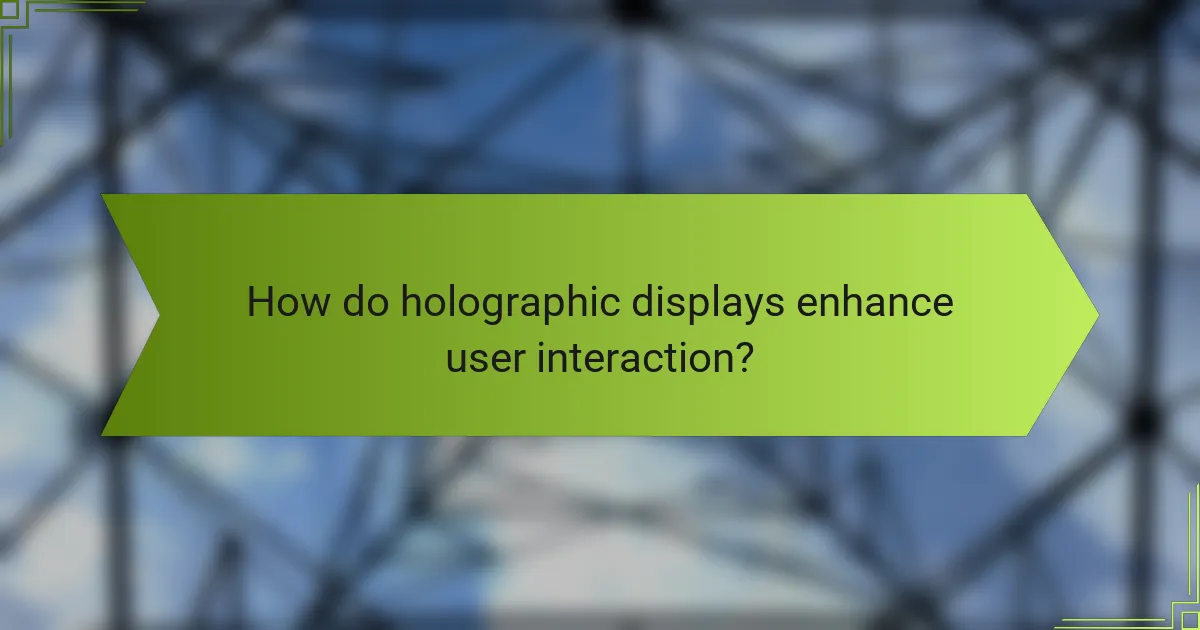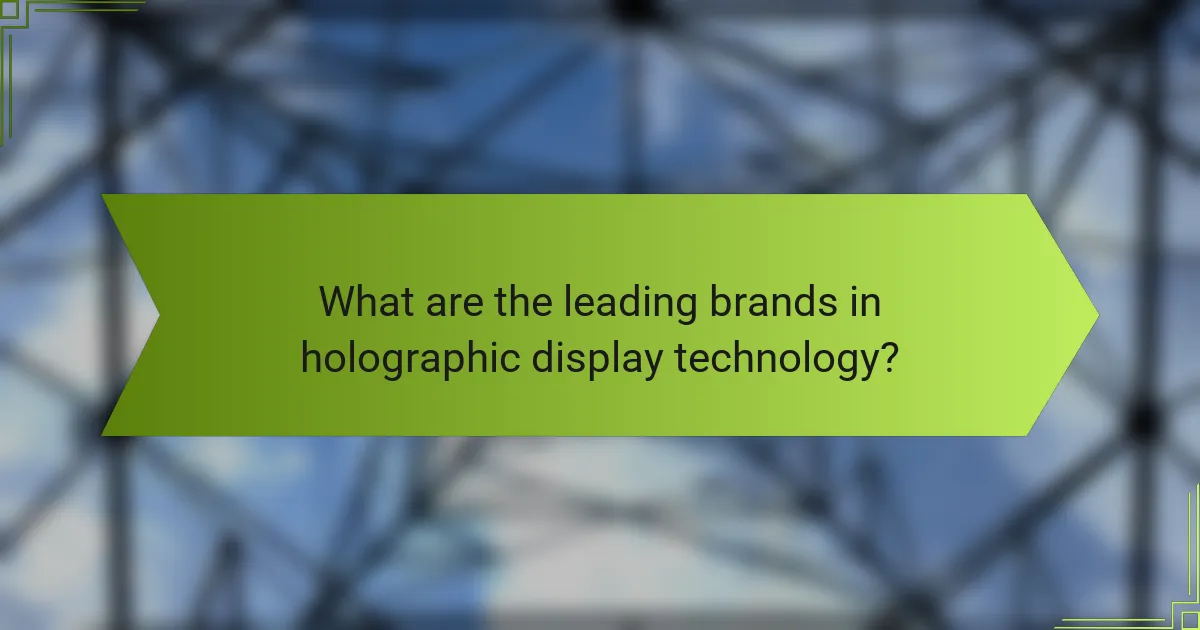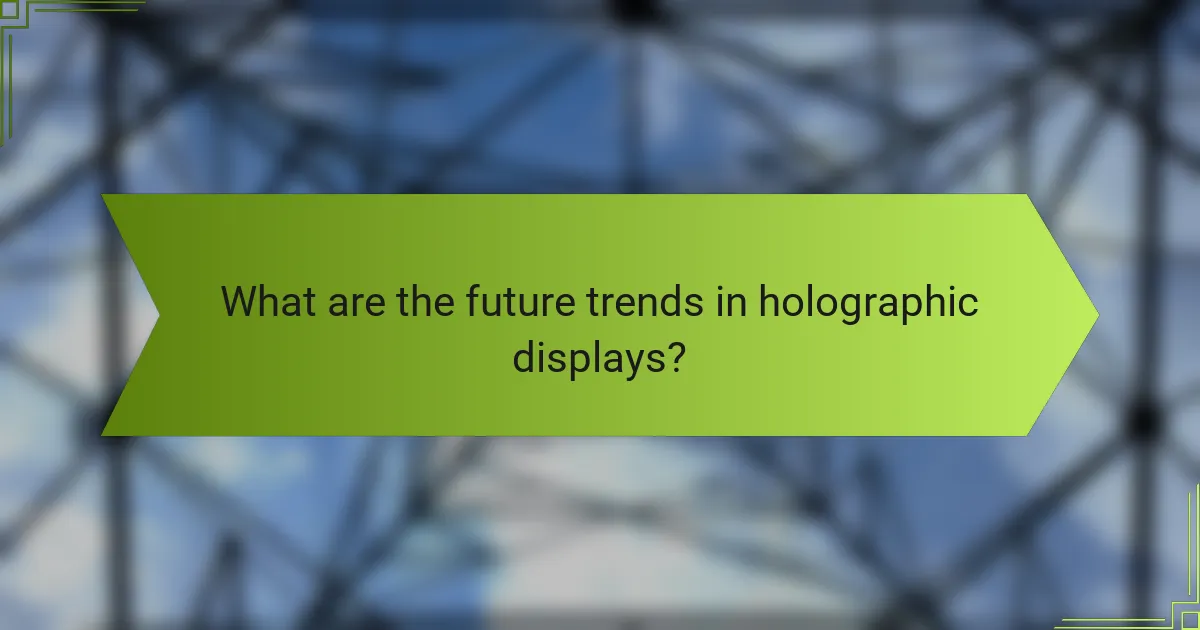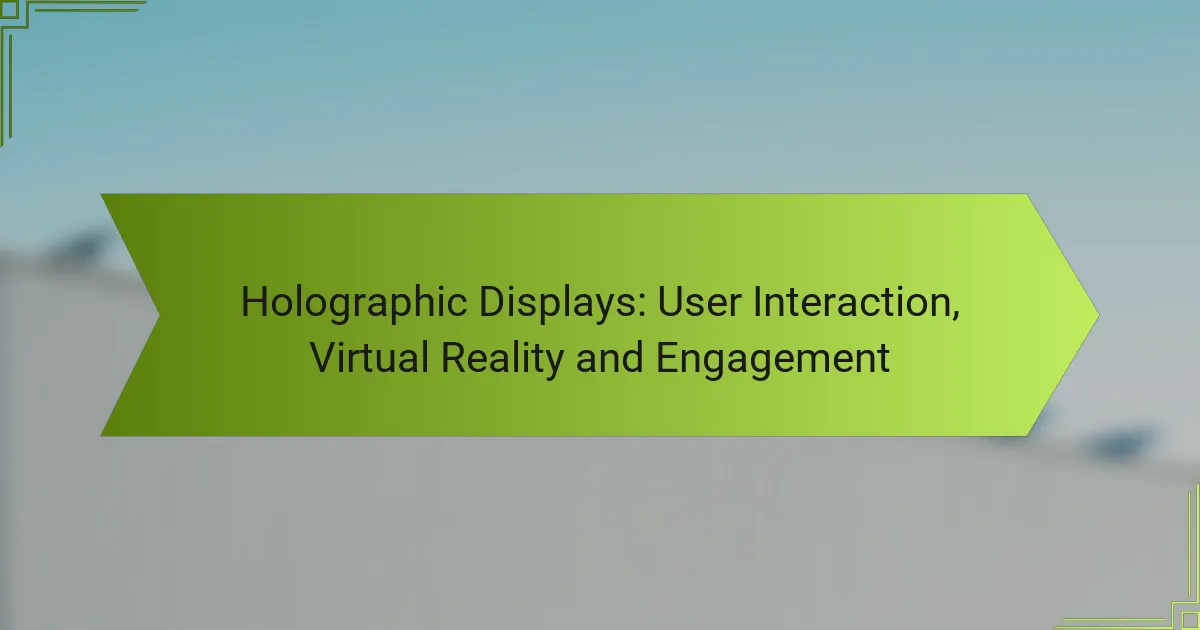Holographic displays revolutionize user interaction by offering immersive and intuitive ways to engage with digital content, allowing manipulation of virtual objects in three-dimensional space. This technology enhances virtual reality experiences across various sectors, including gaming, training, and healthcare, by creating realistic environments that foster deeper user engagement. Additionally, in marketing, holographic displays captivate consumer attention through dynamic and interactive presentations, strengthening connections between brands and their audiences.

How do holographic displays enhance user interaction?
Holographic displays significantly enhance user interaction by providing intuitive and immersive ways to engage with digital content. They allow users to manipulate virtual objects in three-dimensional space, creating a more natural and engaging experience compared to traditional screens.
Gesture recognition technology
Gesture recognition technology enables users to interact with holographic displays through hand movements and body gestures. This technology uses cameras and sensors to track user motions, translating them into commands for the holographic interface. For example, a simple wave of the hand can rotate a virtual object, making the interaction feel seamless and fluid.
Common systems utilize infrared sensors or depth cameras to accurately detect gestures. Users should be aware that lighting conditions can affect performance, so optimal setups often require controlled environments to minimize interference.
Touchless controls
Touchless controls in holographic displays allow users to engage with content without physical contact, enhancing hygiene and accessibility. This feature is particularly useful in public spaces or during collaborative sessions, where multiple users can interact simultaneously without the need for shared devices.
Implementing touchless controls involves using sensors that detect proximity and movement. Users should ensure that their gestures are clear and deliberate, as subtle movements may not register accurately. Regular calibration of the system can improve responsiveness and accuracy.
Immersive environments
Immersive environments created by holographic displays transport users into a virtual space where they can interact with 3D models and simulations. This technology is widely used in fields such as education, gaming, and training, providing a rich context for learning and engagement.
To maximize the benefits of immersive environments, users should consider the design of the space and the placement of the display. Ensuring that the holographic content is well-integrated into the physical surroundings enhances the overall experience. Additionally, users should be mindful of potential motion sickness in prolonged sessions, taking breaks as needed to maintain comfort.

What are the applications of holographic displays in virtual reality?
Holographic displays enhance virtual reality (VR) by providing immersive, three-dimensional visuals that improve user interaction and engagement. These displays are utilized across various sectors, including gaming, training, and healthcare, to create realistic environments and experiences.
Gaming experiences
Holographic displays revolutionize gaming by offering players a more immersive experience. Gamers can interact with 3D environments and characters, making gameplay more engaging and realistic. For example, titles that utilize holographic technology allow players to see their surroundings from different angles, enhancing strategy and interaction.
When designing games for holographic displays, developers should consider the balance between visual fidelity and performance. High-quality graphics can enhance immersion, but they may require more powerful hardware, which can limit accessibility for some users.
Training simulations
In training simulations, holographic displays provide realistic scenarios for various fields, such as aviation, military, and emergency response. Trainees can practice skills in a safe, controlled environment, allowing for hands-on experience without real-world consequences. For instance, pilots can simulate flight conditions and emergency situations using holographic displays.
Effective training programs should incorporate feedback mechanisms to assess performance and improve skills. It’s essential to ensure that the simulations are as realistic as possible, which may involve regular updates to the holographic content based on real-world developments.
Medical visualization
Holographic displays are increasingly used in medical visualization, allowing healthcare professionals to view complex anatomical structures in 3D. This technology aids in surgical planning and education, enabling surgeons to visualize organs and tissues before performing procedures. For example, holograms can help in understanding tumor locations and planning surgical approaches.
When implementing holographic technology in medical settings, it is crucial to ensure compliance with healthcare regulations and standards. Training for medical staff on how to effectively use these displays can enhance their utility and improve patient outcomes.

How do holographic displays improve engagement in marketing?
Holographic displays enhance engagement in marketing by providing immersive and interactive experiences that capture consumer attention. These displays allow brands to present products in a dynamic way, fostering deeper connections with potential customers.
Interactive advertisements
Interactive advertisements using holographic displays enable consumers to engage directly with the content. For instance, users can manipulate 3D models of products, allowing them to explore features and benefits in real-time. This hands-on approach can significantly increase retention rates and brand recall.
To maximize effectiveness, ensure that the interactive elements are intuitive and accessible. Avoid overly complex interactions that may frustrate users, and focus on clear calls to action that guide them through the experience.
Product demonstrations
Holographic displays are particularly effective for product demonstrations, as they allow potential buyers to visualize products in a three-dimensional space. For example, a car manufacturer might showcase a new model with a holographic display that highlights its features and performance metrics. This method can create a memorable impression compared to traditional flat advertisements.
Consider using holographic displays in retail environments or trade shows where consumers can interact with the product virtually. This can lead to higher engagement and conversion rates, as customers feel more connected to the product before making a purchase.
Event experiences
At events, holographic displays can transform the attendee experience by creating captivating visual narratives. Brands can use holograms to tell their story or showcase their values, making the event more engaging and memorable. For instance, a fashion brand might use holograms to present a runway show that allows attendees to see garments from various angles.
When planning an event, ensure that the holographic content aligns with the overall theme and objectives. This coherence will enhance the audience’s experience and encourage them to share their impressions on social media, further amplifying brand visibility.

What factors should be considered when choosing a holographic display?
When selecting a holographic display, consider display resolution, interaction capabilities, and size and portability. These factors significantly influence the overall user experience and effectiveness of the technology in various applications.
Display resolution
Display resolution is crucial for achieving clear and detailed holographic images. Higher resolutions, typically measured in pixels per inch (PPI), provide sharper visuals, which enhance the realism of the holograms. Look for displays that offer at least 1080p resolution for basic applications, while advanced uses may benefit from 4K or higher.
Additionally, consider the pixel density, as a higher density reduces the visibility of individual pixels, resulting in a smoother image. For professional applications, a resolution of 300 PPI or more is often recommended to ensure high fidelity in visual presentations.
Interaction capabilities
Interaction capabilities determine how users engage with holographic displays. Touch, gesture recognition, and voice commands are common methods that enhance user experience. Displays with advanced interaction features allow for more intuitive and immersive experiences, making them suitable for applications in education, entertainment, and design.
When evaluating interaction capabilities, consider the technology behind gesture recognition and the responsiveness of touch interfaces. Systems that support multi-user interaction can also provide a more collaborative environment, which is essential for team-based projects.
Size and portability
The size and portability of a holographic display affect its usability in different settings. Larger displays may offer more immersive experiences but can be cumbersome to transport and set up. Conversely, smaller, portable models are ideal for on-the-go presentations and demonstrations.
When choosing a display, assess your specific needs. For fixed installations, larger screens may be preferable, while portable options are better for mobile applications. Ensure that the weight and dimensions align with your intended use, especially if frequent relocation is required.

What are the leading brands in holographic display technology?
The leading brands in holographic display technology include Microsoft, Vive, and Looking Glass Factory. These companies are at the forefront of developing innovative solutions that enhance user interaction and engagement in virtual environments.
Microsoft HoloLens
Microsoft HoloLens is a mixed reality headset that integrates holograms into the user’s real-world environment. It uses advanced sensors and spatial mapping to create immersive experiences, making it popular in industries like healthcare and education.
Key features include hand tracking and voice commands, allowing users to interact with holograms seamlessly. The device is particularly effective for collaborative work, enabling multiple users to engage with the same virtual content simultaneously.
Vive XR Suite
The Vive XR Suite by HTC offers a comprehensive platform for virtual and augmented reality experiences, focusing on business applications. It combines hardware and software solutions, including the Vive Focus headset, to deliver interactive environments for training, design, and remote collaboration.
One of its strengths is the ability to customize applications for specific business needs, enhancing user engagement. The suite supports various content formats, making it versatile for different industries, from architecture to gaming.
Looking Glass Factory
Looking Glass Factory specializes in holographic displays that do not require glasses, allowing for a more natural viewing experience. Their products, such as the Looking Glass Portrait, cater to creators and developers by enabling them to visualize 3D content in real-time.
The technology is particularly useful for artists and designers, as it allows for intuitive interaction with digital models. Users can manipulate holograms from different angles, providing a unique perspective that enhances creativity and innovation.

What are the future trends in holographic displays?
The future of holographic displays is poised for significant advancements, particularly in user interaction, virtual reality, and overall engagement. As technology evolves, we can expect more immersive experiences that integrate seamlessly into everyday life.
Advancements in AI integration
Artificial intelligence is set to revolutionize holographic displays by enhancing user interaction and personalization. AI algorithms can analyze user behavior and preferences, allowing for tailored holographic content that responds dynamically to individual needs.
For instance, AI can facilitate gesture recognition, enabling users to manipulate holograms with natural movements. This integration not only improves usability but also creates more engaging experiences in gaming, education, and training simulations.
Increased accessibility
As holographic technology matures, accessibility will become a key focus, making these displays available to a broader audience. Efforts are underway to reduce costs and improve user-friendly interfaces, which will help democratize access to holographic experiences.
Moreover, advancements in mobile technology may lead to portable holographic displays, allowing users to engage with holograms on-the-go. This could transform industries such as retail, where customers can visualize products in 3D before making a purchase, enhancing decision-making and satisfaction.
